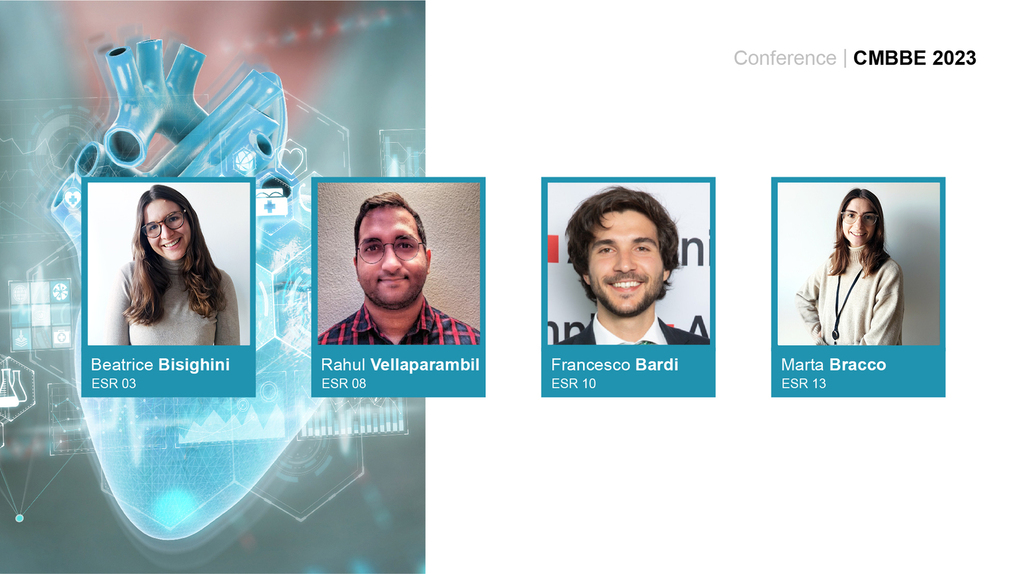The MeDiTATe project at the 18th International Symposium on Computer Methods in Biomechanics and Biomedical Engineering (CMBBE)

The MeDiTATe project will be present at the 18th International Symposium on Computer Methods in Biomechanics and Biomedical Engineering (CMBBE 2023). The event will take place on 3 – 5 May 2023 in Paris, France.
In this occasion four of our Early-Stage Researchers (ESRs) will be presenting the results of their activities:
Beatrice Bisighini – ESR 03: Towards a real-time simulator of flow diverters deployment based on model order reduction. This work presents a feasibility study of a fast and accurate reduced-order modelling scheme, based on finite element simulations and machine learning, to compute the deployed configuration of flow diverters within idealized vascular models in real-time. Flow diverters are very dense braided stents used in the endovascular treatment of cerebral aneurysms. Computational tools could be useful in assisting surgeons in the selection of the best device for a patient, especially in complex cases. However, due to the large amount of degrees of freedom and the necessity to solve the contact with the wall, the computational time required by traditional techniques alone, such as finite element modelling, is excessively high. Machine learning-based reduced order modelling can enable real-time prediction while retaining the mechanical realism and predictability of the stent deployed configuration.
Rahul Sathish Vellaparambil – ESR 08: In silico analysis of Auxetic inspired stent-grafts for endovascular aortic repair. In this study, the bending behaviour of auxetic inspired stent-graft (SG) designs are numerically simulated using finite element method and contrasted with results of a commercial SG (Zenith ® Low Profile) published in literature. The bending behaviour of all SG finite element based models were assessed using a computational benchmark comprising of bending until 180° and intraluminal pressurization at 150mmHg to replicate conditions observed in complex aortic aneurysms. The SG flexibility and SG durability are evaluated using the maximal luminal reduction rate, maximal stresses in stents and maximal strains in fabric respectively. Certain auxetic inspired SG designs have been identified by results that can match or surpass Zenith SG in terms of its flexibility & durability characteristics.
Francesco Bardi – ESR10: Preoperative hemodynamic simulation of a patient specific evar procedure. In this work, we present an in-silico approach to preoperatively assess risk of limb occlusion by analysing the hemodynamic behaviour inside an implanted stent-graft. Firstly, a patient-specific simulation of stent-graft deployment was performed. Vessels were segmented from preoperative CT-scan and meshed with shell elements. The implanted stent-graft was modelled using beam and shell elements, and the deployment simulation was performed using Abaqus explicit solver. From the final configuration, the graft volume was meshed, and a CFD simulation was set up using OpenFOAM V2112. The simulation highlighted a recirculation zone which can be associated with a risk of thrombosis.
Marta Bracco–ESR 13: Validation of abdominal aortic aneurysm motion tracking with simulated ultrasound cine-loops. The presented work is a validation study of the tracking algorithm “Sparse Demons” applied to the specific case of abdominal aortic aneurysm time-resolved 2D ultrasound sequences. The goal of using this algorithm is to study the in vivo motion of the aneurysm wall. In order to validate this algorithm, we have simulated realistic ultrasound sequences using real images as template and we have imposed a displacement field obtained with a finite element simulation. We have then applied the “Sparse Demons” tracking algorithm to the simulated sequence and proven its ability to reconstruct the overall displacement field in the AAA wall, although localized error peaks were present, likely due to low image quality.
